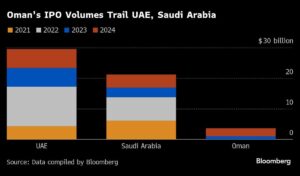Oman’s IPO Landscape: Rising Challenges and Future Opportunities
In 2023, Oman achieved a remarkable milestone with a staggering $2.5 billion in new share sales, allowing it to overtake traditional markets like the UK. This robust performance, backed by the Oman Investment Authority, highlighted the Sultanate’s growing attraction for investors. However, as the dust settles on last year’s successes, 2025 poses significant challenges for Oman’s IPO market amid shifting investor sentiment and fluctuating energy prices.
The Crucial Test: Asyad Group’s Upcoming IPO
Asyad Group, a government-backed company, is set to sell at least a 20% stake in its shipping division, Asyad Shipping Co. This IPO is not only a pivotal moment for the company but also a crucial test for Oman’s broader divestment strategy. The government has identified approximately 30 assets for privatization, and Asyad Shipping’s performance may serve as an indicator of market appetite for future offerings.
Nishit Lakhotia, head of research at SICO Bank, asserts that "Asyad’s success will be a much-needed catalyst for many more IPOs in the sultanate." Recent IPOs, however, have not met investor expectations. For instance, shares like those of OQ Exploration & Production SAOG have plummeted 17% since their October debut, reflecting a cautious market atmosphere.
Recent IPO Performance and Market Sentiment
The lackluster performance of recent IPOs raises questions about the viability of future offerings in Oman. OQ Gas Networks SAOC and Abraj Energy Services SAOG have both seen their stocks drop by 6% and nearly 4%, respectively, since their listings. The prevailing sentiment in the investment community leans towards skepticism, primarily driven by weak energy sector forecasts and the regional oil price volatility.
According to Hasnain Malik, an emerging markets strategist, recent IPOs linked to the oil and chemicals sectors have struggled due to the current unattractive energy prices, impacting overall investor confidence.
Investment Climate: Setting the Stage for Future Growth
Despite these challenges, Oman’s investment landscape is evolving. Its benchmark MSX 30 Index recently declined by 3%, while regional indices, such as the MSCI GCC Countries Combined Index, have appreciated by nearly 4%. Brent crude prices have also enjoyed a 7.5% increase, suggesting that while Oman’s market faces obstacles, the global economic backdrop is not entirely bleak.
Asyad Shipping is strategically positioned to leverage its essential marine transportation services for key exports, casting it as a “relatively safe and sticky” investment option, according to Lakhotia. A potential generous dividend policy may further entice investors as the company seeks to build credibility and instill confidence in the market.
Regulatory Changes: A Boost for Capital Market Development
Oman has historically lagged behind its regional neighbors, Saudi Arabia and the UAE, in the development of its capital markets. Currently, the Muscat Stock Exchange remains one of the smallest bourses in the Gulf region, with a market capitalization barely exceeding $31 billion. However, the authorities are taking proactive measures. In August, Oman’s capital markets regulator approved initiatives aimed at boosting private-sector listings and fostering secondary market liquidity.
These reforms are expected to act as a catalyst for long-term growth, creating a more appealing environment for local and international investors.
The Pursuit of Emerging Market Status
As part of its strategic vision, Oman is also chasing an upgrade to emerging-market status. Currently, it stands as the only nation in the Gulf Cooperation Council alongside Bahrain that MSCI Inc. does not classify as an emerging market. While Oman has “some way to go” to meet the requisite market capitalization criteria for this upgrade, analysts like James Swanston from Capital Economics note that an improving economic backdrop could enhance its appeal.
Conclusion: Navigating Future IPOs
The road ahead for Omani IPOs is fraught with uncertainties, especially given the stretched valuations that have plagued many recent listings across the Middle East. Asyad Shipping, for example, aims for a valuation upwards of $1 billion—an ambitious target in the current climate.
However, success stories from recent IPOs in neighboring Saudi Arabia, like Nice One Beauty Digital Marketing Co. and Almoosa Health Co., underscore the potential for investor interest in the Gulf’s private sector. Malik optimistically states, “This should not prevent Oman from executing more privatizations, just maybe not at as high valuations as it previously hoped for.”
Ultimately, the balance between cautious optimism and the reality of market dynamics will determine the future trajectory of Oman’s IPO landscape. As investors and the government navigate this complex terrain, the focus will remain on fostering a resilient and diversified economy for the Sultanate.

